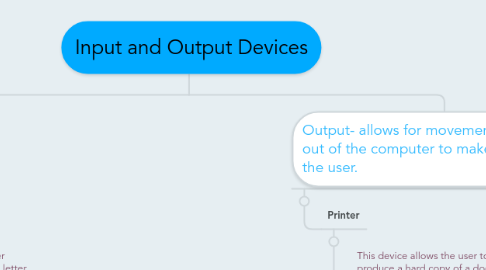
1. Input- allows users to input commands and data to the computer.
1.1. Keyboard
1.1.1. This device allows the user to enter data using numbers, symbols, and letter keys.
1.1.1.1. Application to Learning: Students can use keyboards to type word documents focusing on which ever writing genre they are learning at the time (i.e. personal narratives, opinion writing, informative writing). Teachers can use keyboards to create documents to share with their students as part of instruction.
1.1.1.1.1. Challenges and Benefits: Challenges may include students, especially early elementary, being unfamiliar with how to use the keyboard and type fluently. Benefits may include more hands-on, and visual opportunities for students to type and create documents on the computer, therefore helping teachers reach a wider range of leaners.
2. Output- allows for movement of information out of the computer to make it accessible to the user.
2.1. Printer
2.1.1. This device allows the user to produce a hard copy of a document or data.
2.1.1.1. Application to Learning: Printers can allow for teachers to provide their students with a hardcopy of an activity that they have created for them. For example I used a printer to provide my students with a physical copy of an activity I created where they needed to fill out the main characters, setting, problem, and solution in order to better understand the story elements of their book.
2.1.1.1.1. Challenges and Benefits: Challenges may include frustrating idle time created by slow printers that cannot handle the number of jobs being sent to it. This happens to our shared printer, which all six of our second grade classrooms print to. There are times when jobs have been backed up for a whole day. Benefits include access to physical documents that students can interact and grow from. Also printers with higher resolution can provide crisp and clear images, which can benefit visual learners, students with special needs, and English Language Learners.
